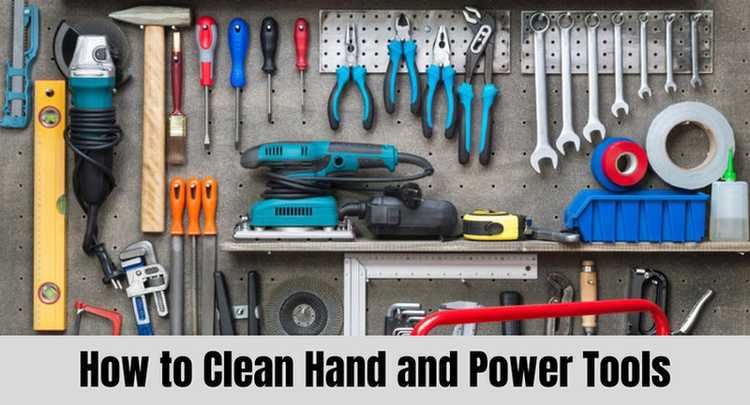It might be a mystery to you how to clean hand and power tools. Well, the answer may surprise you. The best way to clean these tools is with something you probably already have in your home.
In addition to the usual detergent and water, you can also use a disinfectant such as rubbing alcohol or a mixture of rubbing alcohol and water. You can spray it directly onto your tools or wipe them with a clean cloth. However, before you choose a disinfectant, it is crucial to evaluate the condition of your tools and the level of cleaning required.
Table of Contents
Scrape Off Excess Dirt
Before you start cleaning any tools, it’s essential to scrape off any excess dirt. You can clean your devices more quickly if you do this. You can use a putty knife, an old toothbrush, or even your fingers to scrape off the dirt. Also, read a guide on how to clean welding helmet lenses.
To clean hand and power tools, you should first wipe down any dirt or grease on the surface with a cloth. You may need a brush to remove all the dirt from the tool. After cleaning, wipe it down with a damp cloth or rag. For stainless-steel tools, you can polish them with a stainless-steel cleaner.
Using Homemade Cleaning Solutions
You can save a lot of money using homemade cleaning solutions to clean your tools. All you need is a little elbow grease and some common household ingredients.
Vinegar is a great all-purpose cleaner. You can use it to clean metal, plastic, or wood tools. To clean your tools with vinegar, soak a cloth in vinegar and wipe down your tools.
Baking soda is another great cleaning agent. It’s especially good at removing rust from metal surfaces. To use baking soda to clean your tools, mix equal parts baking soda and water to form a paste. Rub the paste onto the surface of your equipment and let it sit for a few minutes before rinsing it off.
Lemon juice is another natural cleanser used to clean tools made of metal or plastic. Apply lemon juice to a cloth and wipe down your tool’s surface. You can also add a little salt to the lemon juice to make an abrasive cleaner for more challenging jobs.
Use Oil/Sand for Cleaning
It is best to use oil for cleaning power tools. Oil helps keep the tools clean and prevents rust from forming on them. Sand is also an effective way to clean both hand and power tools.
The process is simple, use a damp cloth to wipe away any dirt or debris from the device, then use a dry cloth to apply sand to the tool. Rub the sand onto the tool in a circular motion until the entire surface is covered. Finally, use a brush or air compressor to remove the sand.
Dish Soap
A household cleaner with an antibacterial ingredient, such as dish soap, helps clean hands and power tools. You can use it to clean rust-infected hand tools like a hammer. A solution of one teaspoon of concentrated dish soap in a gallon of water will clean metal tools without harming them. This solution can clean your hand and power tools and rinse them afterward.
You can also use a cleaning agent such as baking soda for a more thorough cleaning. It is very effective in cleaning tools and can be used to make a cleaning paste.
Baking Soda
If you’re looking for an inexpensive way to clean power tools, try using baking soda. This simple cleanser can help you remove rust and other particles. Mix baking soda with one part water and wipe the tool down. This solution is also effective for eliminating stains and odors.
Another option is to use a commercial cleaner. A commercial cleaner contains hydrogen peroxide and baking soda, effectively cleaning your power and hand tools. However, purchase a tool-specific cleaner, like one made for contractors. This way, you won’t have to worry about the chemicals causing a toxic smell.
Baking soda also has a mildly abrasive action, which means it won’t scratch your surface. It also works wonders to scrub nooks and crannies. For example, you can use a baking soda paste to clean power tools and stainless steel sinks.
WD-40
If you’re looking for a simple way to clean your hand and power tools, WD-40 is the solution. This unique solvent/lubricant is widely available and found in nearly every toolbox. Developed in 1953 after 40 attempts to establish a corrosion-prevention formula, WD-40 has many uses for hand and power tools. It removes dirt, grime, and gunk from tools. Unlike other solvents, WD-40 does not cause the metal to rust so you can clean virtually any metal object with it.
WD-40 is a lightweight degreaser that shouldn’t leave residue on your hand tool. After applying it to the instrument, rinse it to remove any excess product. Regular use of it will help your hand tool stay clean for longer.
Conclusion
The costs of power tools are high. Keep them clean to ensure they last as long as possible. You can extend the life of your power tool by following these steps.
After each use, spot-clean your power tools in addition to the rigorous cleaning described above. The most effective way to store power tools is to keep them clean. It will save you a lot of time and effort if you immediately remove any residue while cleaning more intensively.

James is a welding expert, accomplished author, and trusted guide with over 8 years of experience in the industry. With his in-depth knowledge and engaging writing style, James has become a true authority in the field, offering readers and clients invaluable expertise and insights to take their welding skills to new heights.

